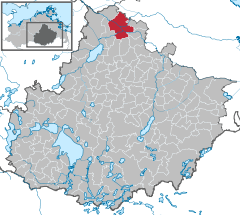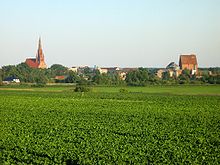- Demmin
-
Demmin 
Coordinates 53°54′18″N 13°02′38″E / 53.905°N 13.04389°ECoordinates: 53°54′18″N 13°02′38″E / 53.905°N 13.04389°E Administration Country Germany State Mecklenburg-Vorpommern District Mecklenburgische Seenplatte Town subdivisions 11 districts Mayor Ernst Wellmer (CDU) Basic statistics Area 80,653 km2 (31,140 sq mi) Elevation 8 m (26 ft) Population 11,890 (31 December 2010)[1] - Density 0 /km2 (0 /sq mi) Other information Time zone CET/CEST (UTC+1/+2) Licence plate DM Postal code 17109 Area code 03998 Website www.demmin.de Demmin (German pronunciation: [dɛˈmiːn]) is a town in the Mecklenburgische Seenplatte district, Mecklenburg-Western Pomerania, Germany. It was the capital of the former district Demmin.
Contents
History
Name
The name possibly originates from the Slavic term "timänie", which translates as "swampy area". Another possible origin for the name of Demmin could be from Old Polabian "dym" (plural; dyminy) for smoke, referring to fire clearances that made a settlement possible. In 1075, Adam of Bremen reported[2] of a fought over castle Dimine. In the course of history, the name changed, and sources refer to Dymine and Dimin, Latinized to Dyminium, finally Demmyn, and from 1320 on, the town was known under its present spelling Demmin.
The folk etymology is as follows: Two princesses, who built castle "Haus Demmin", promised each other in the Low German language spoken in Demmin, "Dat Hus is din und min" which translates "That house is yours (din) and mine (min)". Thus, the name of the castle and of the city is said to have developed.[3][4]
Prehistory
As early as 5500 - 4900 BC, the Neolithic Linear Pottery culture spread from the East, and from the Oder river into the area east[5] of Demmin. The great dolmen near Upost[6] is classified as the eastern most great dolmen.[7] As an evidence of the Funnelbeaker culture, 119 Megalith constructions bear witness around the county of Demmin.[8] Of these, 56 are partially preserved. The majority of these constructions are 37 Dolmen The fact that there are also six simple dolmen preserved, makes Demmin and its surrounding area one of those regions in which the construction of such facilities had its roots. The later period is characterized by 12 preserved in the district of Demmin Tumulus and basin stones. From about 1800 BC on, the settlement of the area by Germanic peoples began.
Saxon Wars to 10th century
 part of the defensive wall of the Slavic castle outside Haus Demmin
part of the defensive wall of the Slavic castle outside Haus Demmin
Slavic settlements of the Veleti in the forests surrounding Demmin can be traced back to the 8th century. In 789,[9] during the Saxon wars, Charlemagne led his troops to the Peene river, against the Veleti who were allies of the Saxons. Dragovit, king of the Veleti, whose castle, civitas Dragowiti[10][11] was said to most likely have been located at Vorwerk (Demmin), submitted to Charlemagne and swore fealty. During the struggle of Veleti and Franks over this very suitable for a settlement region which was important due to its location at the crossing of rivers and trade roads of times to come, a border castle was erected by Lutici Circipanians at the dawn of the 10th century.[12] That castle was later called “Haus Demmin”. It controlled the Eastern parts of Circipania, a territory that stretched to Güstrow in the west. Its main castle was Teterow.
Middle Ages
Demmin was a stronghold of the West Slav Circipanes during the Middle Ages. Due to its strategical importance, burghs were erected (and often attacked and destroyed) at the Vorwerk and Haus Demmin sites, named Dimin or Dymin. A Saxon army unsuccessfully besieged the settlement during the 1147 Wendish Crusade. Yet, the armed conflicts with their neighbors and invasion troops from Germany and Denmark devastated the Circipanes land badly. It was resettled by Germans and Flames by the 12th to 14th centuries. Circipania was split between Mecklenburg and Pommern, with Demmin on the Pomeranian side becoming a residence town for Pomeranian dukes (Teilherzogtum Pomerania-Demmin).
Modern Age
Like most of Pomeranian areas aside the larger coastal Hanse cities, the character of Demmin and its surrounding areas remained rural and dominated by agriculture until today, even though Demmin had been a member of the Hanse league because of the rivers (e.g. the Peene River) connecting this area to the Baltic coast.
During the Thirty Years' War, Demmin was occupied by imperial forces from 1627 to 1630,[13] and thereafter by Swedish forces.[14]
In the Weimar Republic Demmin was a stronghold of the nationalistic organisations DNVP and the Stahlhelm. Even before 1933 there were boycotts of Jewish businesses, which drove away most of the Jews and the synagogue was sold in June 1938 at a furniture company, which is why it survived as a building today. On 11 November 1938 thousands gathered in the square in anti-Semitic demonstration.[15] In the last free national elections to the Reichstag on 5 March 1933 the National Socialist Party won 53.7 percent of votes in Demmin[16]
During World War II, Poles, Russians, as well as POWs from France and Belgium were used as forced labour in the town.
German troops destroyed the bridges over the Peene while retreating from Demmin during World War II. This way, the advance of the Soviet Red Army was slowed down when they arrived in Demmin on 30 April 1945. During that night and the following morning, Demmin was handed over to the Red Army largely without fighting, similar to other cities like Greifswald. Rapes, pillage and executions committed by Red Army soldiers triggered a mass suicide of hundreds of people, nearly all of the Old Town was burned down.[17]
Coat of arms
The coat of arms of Demmin displays:
- a red fortress with three open gates
- the two towers are topped by a silver lily
- a leaned to the right silver shield displaying a
- red griffin is the heraldic animal of Pomerania
- On top of the shield there is a crowned, blue helmet with green peacock feathers
- The red fortress symbolizes the city's history as the residency of Pomeranian princes
- The lily crowning both towers symbolizes the city flower used in the 18th century.
Famous residents
- Joachim Lütkemann (1608–1655), preacher and author
- Heinrich Carl von Schimmelmann (1724–1782), merchant and politician
- Julius Friedrich Cohnheim (1839–1884), pathologist
- Willy Schulz-Demmin (1892–1974), painter
- Hans-Adolf Asbach (1904–1976), politician
- Willi Laatsch (1905–1997), pedologist
- Paul von Maltzahn (born 1945), diplomat
- Andy Glandt, banjo player
Literature
- Norbert Buske, Das Kriegsende in Demmin 1945 (German) - The End of the War in Demmin 1945
References
- ^ "Bevölkerungsentwicklung der Kreise und Gemeinden" (in German). Statistisches Amt Mecklenburg-Vorpommern. 31 December 2010. http://service.mvnet.de/statmv/daten_stam_berichte/e-bibointerth01/bevoelkerung--haushalte--familien--flaeche/a-i__/a123__/2010/daten/a123-2010-22.pdf.
- ^ Gesta Hammaburgensis ecclesiae pontificum
- ^ Der Name Demmin - Sage zur Namensgebung. In: Die Volkssagen von Pommern und Rügen. S. 171 (1840)
- ^ Eichblatt, Hermann: Sagen, Volksglaube und Bräuche aus Demmin und Umgebung. Demmin 1925, cap. 1.
- ^ Schuldt, Ewald (Hg.): Bodendenkmalpflege in Mecklenburg. Jahrbuch 1969, Berlin, Deutscher Verlag der Wissenschaften 1970 pp. 321
- ^ Great Dolmen near Upost
- ^ Schuldt, pp. 321
- ^ Sprockhoff, Ernst: Atlas der Megalithgräber Deutschlands Teil 2: Mecklenburg - Brandenburg - Pommern (1967) ISBN 978-3-7749-0743-0
- ^ Einhard: The Life of Charlemagne; ISBN 047206035X
- ^ Aspekte der Nationenbildung im Mittelalter: Ergebnisse der Marburger Rundgespräche 1972-1975. Pages 206ff. ISBN 3799561013
- ^ Stolle, Wilhelm Carl: Beschreibung und Geschichte der Hauptstadt Demmin. Greifswald 1772, page 481.
- ^ Barthold, Friedrich Wilhelm: Geschichte der deutschen Städte und des deutschen Bürgerthums, Volumes 1-2; ISBN 1149262028
- ^ Langer, Herbert (2003). "Die Anfänge des Garnisionswesens in Pommern". In Asmus, Ivo; Droste, Heiko; Olesen, Jens E. (in German). Gemeinsame Bekannte: Schweden und Deutschland in der Frühen Neuzeit. Berlin-Hamburg-Münster: LIT Verlag. p. 403. ISBN 3825871509. http://www.google.de/books?id=nI9dItT816kC&pg=PA397.
- ^ Langer, Herbert (2003). "Die Anfänge des Garnisionswesens in Pommern". In Asmus, Ivo; Droste, Heiko; Olesen, Jens E. (in German). Gemeinsame Bekannte: Schweden und Deutschland in der Frühen Neuzeit. Berlin-Hamburg-Münster: LIT Verlag. p. 397. ISBN 3825871509. http://www.google.de/books?id=nI9dItT816kC&pg=PA397.
- ^ Artikel Demmin in: Irene Diekmann (Hg.), Wegweiser durch das jüdische Mecklenburg-Vorpommern, Potsdam 1998, S. 99 ff, bes. S. 111 f
- ^ Thomas Schreck: Echt deutsch und antional - Die vorpommersche Kleinstadt Demmin im Jahr 1933, in: Zeitgeschichte regional 4/4 (2000), S. 14-23
- ^ Buske, Norbert (Hg.): Das Kriegsende in Demmin 1945. Berichte Erinnerungen Dokumente (Landeszentrale für politische Bildung Mecklenburg-Vorpommern. Landeskundliche Hefte), Schwerin 1995, in German (The End of the War in Demmin 1945 - Reports, Reminiscences, Documents). ISBN 3-931185-04-4.
External links
- Official website (German)
- Official website of the Demmin Historian Wolfgang Fuhrmann (German)
- Pomeranian Princes castle in Demmin (Haus Demmin) (Polish)
Geography of Pomerania Regions CurrentVorpommern (Western or Hither Pomerania) · Zachodniopomorskie · Pomerelia (Kashubia) · Pomerania euroregionAdministration Towns ListsList of towns in Vorpommern · List of towns in Farther Pomerania · Pomeranian cities, towns and villages · List of placenames in the Province of Pomerania (A-H · I-P · Q-Z)Largest>100,000>50,000Islands Peninsulae Rivers Lakes Bays, lagoons National parks History of Pomerania 10,000 BC–600 AD · 600–1100 · 1100–1300 · 1300–1500 · 1500–1806 · 1806–1933 · 1933–1945 · 1945–presentAdministrative Billung March · Northern March · Principality of Rugia ·
Duchy of Pomerania (House of Pomerania · List of Dukes · Cammin · Gützkow · Schlawe-Stolp · Lauenburg-Bütow · Partitions · P.-Stolp) · Swedish Pomerania · Brandenburgian Pomerania (Draheim)
Pomerania Province (1815-1945) (Neumark · Posen-West Prussia · List of placenames) · Mecklenburg-VorpommernZachodniopomorskie
(after 1945)Medieval duchies (Samborides) · State of the Teutonic Order · Royal Prussia (Pomeranian Voivodeship (1466–1772)) · Free City of Danzig (1807–14) · West Prussia · Pomeranian Voivodeship (1919–39) (Polish Corridor) · Free City of Danzig (1920–39) · Reichsgau Danzig-West Prussia · Pomeranian Voivodeship (Kashubian placenames)Ecclesiastical Conversion of Pomerania · Diocese of Kolberg (hist.) (Congress of Gniezno) · Diocese of Cammin (hist.) Diocese of Culm (hist.) · Diocese of Roskilde (hist.) · Diocese of Włocławek (Leslau) (hist.) · Prelature of Schneidemühl (hist.)
Archdiocese of Berlin · Archdiocese of Szczecin-Kamień · Diocese of Koszalin-Kołobrzeg · Diocese of PelplinProtestant Reformation · Evangelical State Church in Prussia (hist.) · Pomeranian Evangelical Church ·Demography Archaeological
culturesHamburg · Maglemosian · Ertebølle-Ellerbek · Linear Pottery · Funnelbeaker · Havelland · Corded Ware · Comb Ceramic · Nordic Bronze Age · Lusatian · Jastorf · Pomeranian · Oksywie · Wielbark · Gustow · Dębczyn (Denzin)PeoplesGepids · Goths · Lemovii · Rugii · Vidivarii · Vistula Veneti ·
Slavic Pomeranians · Prissani · Rani · Ukrani · Veleti · Lutici · Velunzani ·
German Pomeranians · Kashubians · Poles · SlovinciansMajor demographic
eventsLanguages
and dialectsTreaties Kremmen (1236) · Landin (1250) · Kępno (1282) · Soldin (1309) · Templin (1317) · Stralsund (1354) · Stralsund (1370) · Thorn (1411) · Soldin (1466) · Thorn (1466) · Prenzlau (1448/72/79) · Pyritz (1493) · Grimnitz (1529) · Stettin (1570) · Franzburg (1627) · Stettin (1630) · Westphalia (1648) · Stettin (1653) · Labiau (1656) · Wehlau and Bromberg (1657) · Oliva (1660) · Saint-Germain-en-Laye (1679) · Lund (1679) · Stockholm (1719/1720) · Frederiksborg (1720) · Kiel (1814) · Vienna (1815) · Versailles (1919) · Potsdam (1945)Categories:- Towns in Mecklenburg-Vorpommern
Wikimedia Foundation. 2010.





